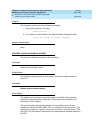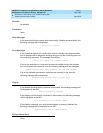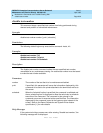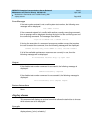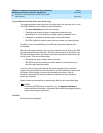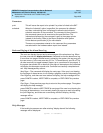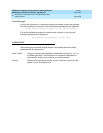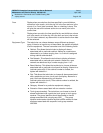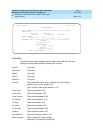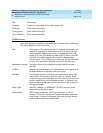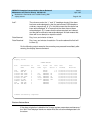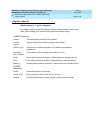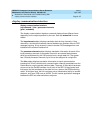
DEFINITY Enterprise Communications Server Release 5
Maintenance and Test for R5vs/si
555-230-123
Issue 1
April 1997
Maintenance Commands and Trouble-Clearing Aids
Page 8-100display alarms
8
From Display alarm records from the time specified by mm/dd/hh/mm,
where mm is the month, dd is the day, hh is the hour and mm is the
minute. If no "from" date is entered, then no checking is done. This
will give the user all the alarms active since a month prior to the
current time.
To Display alarm record to the time specified by mm/dd/hh/mm, where
mm is the month, dd is the day, hh is the hour and mm is the minute.
If no "to" date is entered, any alarm which is active after the from date
will be selected.
Equipment Type The technician can choose between seven different equipment
types. If there is no input to any of these fields, the system will default
to all the equipment. The user can select one of the following fields:
■ Cabinet: This allows the technician to display all alarms
associated with a particular cabinet. Alarms for a cabinet are
referenced by a number ranging from 1 to 3 which is assigned
during cabinet administration.
■ Port Network: This allows the technician to display all alarms
associated with a particular port network. Alarms for a port
network are referenced by a number ranging from 1 to 3.
■ Board Number: This allows the technician to choose all alarms
associated with a particular circuit pack for display. Alarms for a
(cabinet-carrier-slot). If the cabinet number is omitted, the
system will default to 1.
■ Port: This allows the technician to choose all alarms associated
with a particular port on a circuit pack for display. Alarms for a
port circuit are referenced by port location
(cabinet-carrier-slot-circuit). If the cabinet number is omitted, the
system will default to 1.
■ Category: Alarms for a particular equipment category.
■ Extension: Alarms associated with an extension number.
■ Trunk (group/member): The technician can choose to view all
alarms associated with a particular trunk group or trunk group
member. The group identifier should be entered to view all
alarms associated with a trunk group XXX/___. The group
identifier and member identifier should both be entered to view
all alarms associated with a specific trunk group member
XXX/XXX.



